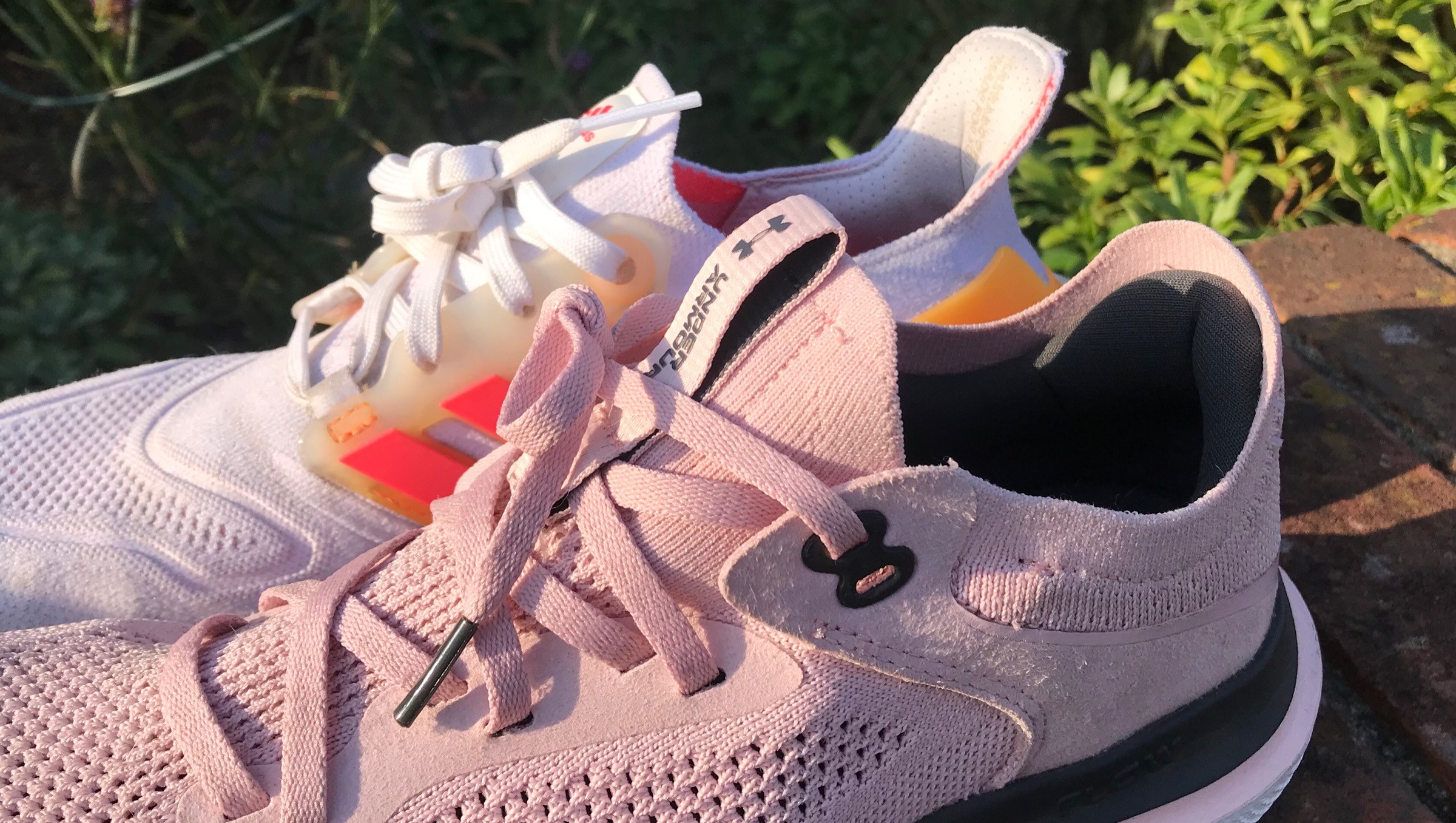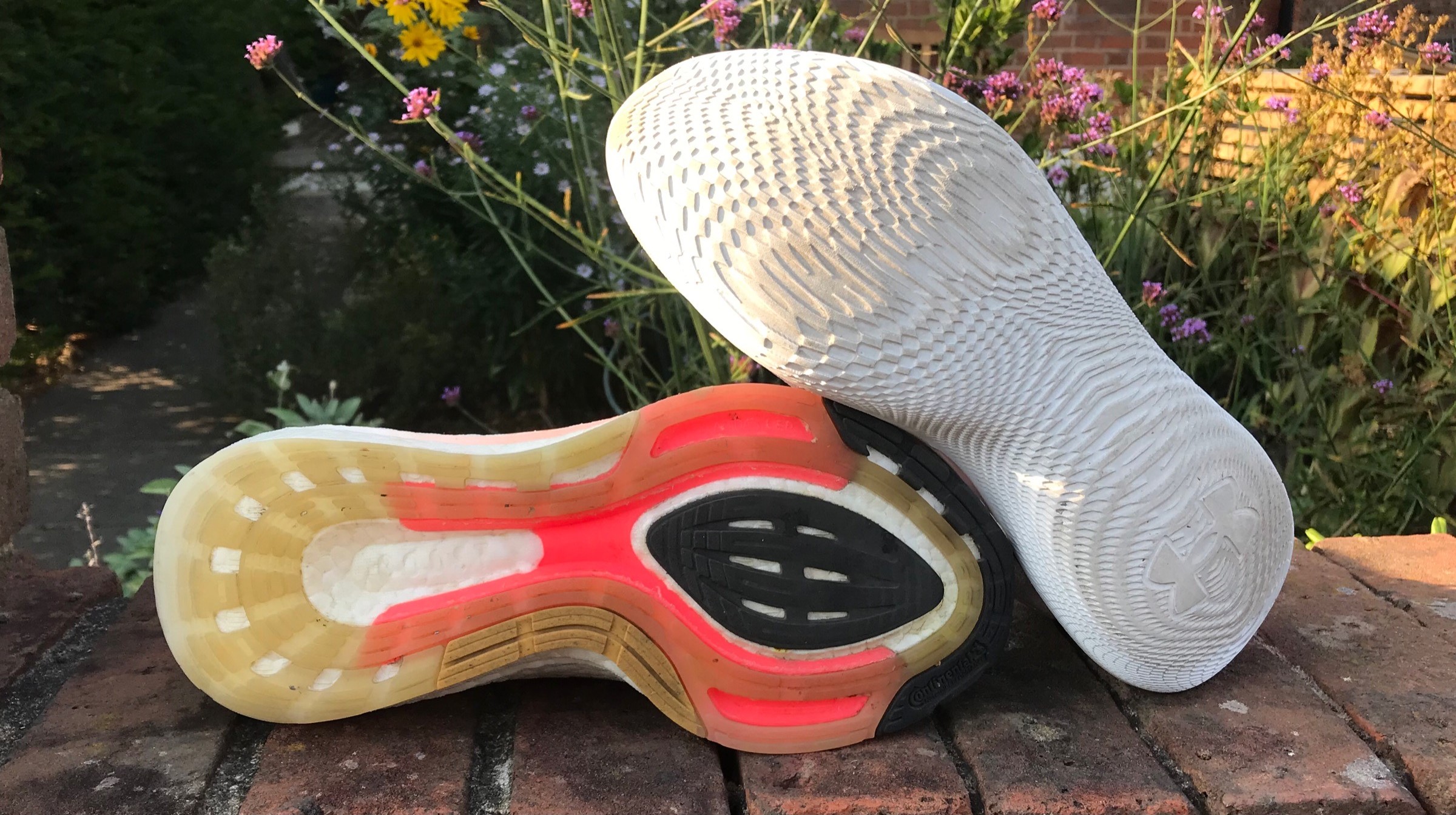Adidas Ultraboost 22 vs Under Armour Flow Synchronicity – Which are the best women's running shoes?
How does Under Armour’s firm ride compare to the bouncy BOOST of Adidas? We have all the answers


If you’re a woman that loves to run, you’ll no doubt be aware of the many exciting developments that have been happening in the world of women-specific running shoes of late. here, we'll compare two of the most popular models, the Adidas Ultraboost 22 and the UA Flow Synchronicity.
While women-specific running shoes have been a firm fixture with more technical trainer brands for years - many of which feature in our pick of the best women’s running shoes - it’s only recently that the BIG shoe brands have begun to get in on the act by investing time and money into developing running shoes that aren’t just scaled down versions of men’s shoes in pink.
Believe it or not, the launch of the female-specific Adidas Ultraboost 22 back in December 2021 was the brand’s very first running shoe designed for women, by an all-woman team, on a women’s last (or foot mould) using a database of 1.2 million foot scans to identify key differences between the male and female foot.
Hot on Adidas’ heels, Under Armour has also entered the women-specific running shoe market for the first time this June with the launch of the UA Flow Synchronicity: their first shoe designed for women, by an all-woman team, on a women’s last, using research from thousands of 3D foot scans.
Sounds familiar, right? But how do these two shoes compare when they are both designed to provide the perfect female fit? I decided to put them through their paces and find out.
Adidas Ultraboost 22 vs UA Flow Synchronicity: Price and availability
The Adidas Ultraboost 22 is available to buy now at Adidas UK / Adidas US for a recommended retail price of £165/$190. In the UK, it comes in a whopping 31 colourways, including the original Cloud White/Turbo/Flash orange seen here, and 20 colourways in the US.
The UA Flow Synchronicity is available to buy now at Under Armour UK / Under Armour US for a recommended retail price of £115/$140. In the UK, it is available in three colourways, including Retro Pink and Black/Metallic Ore. A few more colourways are available in the States.
Get all the latest news, reviews, deals and buying guides on gorgeous tech, home and active products from the T3 experts
For the latest prices in Australia, check out the price widget just below or at the bottom of this article.
Adidas Ultraboost 22 vs UA Flow Synchronicity: Tech and ergonomics
Following 'hundreds of prototypes and multiple instances of fine-tuning', Adidas claims, the Ultraboost 22 boasts a '360° improved fit featuring a completely redesigned S-curve heel pocket' that’s narrower right up to the Achilles tendon to avoid slippages, plus a shallower forefoot profile and a lower instep curve, the latter of which is significantly different on a women’s foot compared to a man’s foot.
Naturally, you still get plenty of plushness and springy cushioning from the BOOST midsole, but the new grippy rubber outsole is more flexible than the male shoes. The result is a shoe that delivers greater comfort, support and cushioning and promises 4 per cent more forefoot energy return compared to the non-female specific Ultraboost 21. This is obviously impossible to verify, but that's just how running shoe marketing works!

Like the Ultraboost 22, the design team behind the Flow Synchronicity focused on three key areas – the heel, the arch, and the midfoot – to create a shoe that secures the heel and supports the arch.
The new heel cup sits tightly to the foot and really stays in place. It’s also very supportive, but some runners may find that it sits too low on the ankle to feel super secure (I didn’t mind as I prefer this design over something that’s too high and causes dreaded ankle rubbing). The shoes are also very supportive for those who overpronate, thanks to the insole, which focuses on the back of the foot.
In contrast to the Ultraboost 22, there’s no outsole on the Flow Synchronicity. Instead, you get the same technology as the Under Armour Flow Velocity Wind 2 shoe, where the Flow midsole cushioning extends right to the pavement, and a grid-like pattern offering naturally sticky traction ensures great grip, even in slippery conditions.

This means the Flow Synchronicity is super lightweight, weighing in at just 8.3 oz/235 grams, compared to the 10.2 oz/ 289 grams of the Ultraboost 22, so if it’s a lightweight shoe you’re after, the Flow Synchronicity is a good bet.
However, if you prize cushioning and plushness over lightness, you may find the Flow Synchronicity lacking. The cushioning is good, but it has a distinctly firmer feel underfoot over concrete, and you certainly don’t sink into it in the same way as the Ultraboost 22.
That said, a firm feel isn’t necessarily a bad thing for beginners who might appreciate a greater ground feel to improve their running technique. Equally, newbies will also love the UA MapMyRun tech built into the midsole that connects to the app via Bluetooth to help you track and analyse running metrics and become a better runner.
Adidas Ultraboost 22 vs UA Flow Synchronicity: Running performance
Both shoes are designed to be an ‘everyday’ running shoe best suited to easy miles, but I’d say the cheaper Flow Synchronicity shoe is definitely more suited to beginners who are doing a few runs a week and are working up to a max of 5-10K distances, whereas the pricier Ultraboost 22 has the sturdiness, durability and cushioning to help you go for longer in maximum comfort.
The Ultraboost 22 also feels flexible and responsive, while the Flow Synchronicity feels a little more rigid and ‘stompy’ underfoot, despite being lighter. That could be because I’ve been wearing my Ultraboost 22 shoes to death for the last five months and am accustomed to their springiness – there’s a reason why they’re currently topping our list of the best women’s running shoes – but it could also be a little down to the shape of the soles; the Ultraboost 22 has a more rounded, rocker-style shape compared to the flatter sole of the Flow Synchronicity, the former of which provides a lovely rolling sensation into the next step.
Of course, that doesn’t mean that runners who like a firmer ride won’t appreciate the Flow Synchronicity. Aside from the distinctly different cushioning, both shoes provide a fantastic fit that’s uber comfy and hits the ground running with no break-in time needed, and they are both extremely supportive around the arches. Most importantly, I haven’t experienced any rubbing, tightness, numbness, or friction with either shoe.

Adidas Ultraboost 22 vs UA Flow Synchronicity: Aesthetics
The Flow Synchronicity has been designed with minimal layers using a flexible micro knit upper that’s designed to 'hug the foot but move and flex with every stride'. It also features seamless construction to avoid irritation, and it certainly feels soft and comfortable. It’s also highly breathable - something I noted during our recent heatwave – with wider mesh holes around the toes, tongue, and sides of the foot.
The heel cup is a great new feature, including a thick padded collar that fits snugly around the heel, encompassed by a layer of mesh that peeps over the collar by around a centimetre and aids the locked-in feel with causing friction.
Comparatively, the Ultraboost 22 has a higher, narrower S-curve heel that envelops the heel right up to the Achilles heel, and if I’m honest, I do prefer it for a feeling of extra security with no abrasion – plus, I think it looks really cool. The new PRIMEKNIT upper, made from a yarn with 50 per cent Parley Ocean Waste, is also highly stretchy, adaptive and breathable, giving a sock-like feel.

In terms of sizing, the Ultraboost 22 is true to size (I ordered a UK size 6.5 as I usually do in running shoes, and these were perfect), although they are on the narrower size of shoes and not particularly suited to those with wide feet.
In contrast, the Flow Synchronicity has a wide, roomy toe box with loads of wriggle room, although it is also a bit longer. I have always found UA shoes to be a bit snug side, so I purposefully sized up a half size. This time around, however, the size 7 Flow Synchronicity shoes left over a thumbs’ worth of space above my longest toe. For that reason, I’d recommend you order true to size or possibly even size down a half size.
In terms of actual looks, I think it comes down to personal taste. Both have sleek uppers and chunky, interestingly textured midsoles, but if you prefer a minimal look with zero logos, you’ll love the Flow Synchronicity. Personally, I prefer the modern look of the Ultraboost 22 shoes with their sexier, more streamlined profile and the addition of the logo in hard plastic, which acts as the lacing system.

Adidas Ultraboost 22 vs UA Flow Synchronicity: Verdict
The Under Armour Flow Synchronicity is a good deal cheaper than the Ultraboost 22, especially when you consider that it has integrated UA MapMyRun technology to measure and analyse running metrics. But from a strict running performance point of view, the Ultraboost 22 is hands down the better choice of the two.
Both shoes are extremely comfortable and offer a perfect fit for the female foot, but the Ultraboost 22 makes running a real pleasure, taking the strain off your joints on long runs and making the action of running itself that little bit easier.
That said, beginner and casual runners who have wide feet, are on a tighter budget, or prefer a firmer ride over shorter distances will really enjoy the Flow Synchronicity.

Jo is a London-based freelance journalist and content creator specialising in fitness, health, lifestyle and beauty. With a degree in Journalism, Film & Broadcasting from Cardiff University and almost 20 years’ experience in the industry, she interviews celebrities and Olympians for a living, while testing out the latest beauty, hair, wellness and fitness gadgets. As a Level 3 Personal Trainer and author of several fitness guides, she gets to try the coolest workouts while reviewing active travel destinations and writing investigative features about the wonderful world of wellbeing for many of the UK’s top magazines, newspapers and digital publications. When she’s not sitting at her laptop, Jo likes exploring new walking spots with her beagle, gardening, and DIY. She is also one of the few people on the planet still obsessed with what’s coming up in Phase 5 of the Marvel Cinematic Universe.